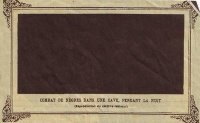Incoherents
From The Art and Popular Culture Encyclopedia

|
Related e |
|
Featured: |
The Incoherents (Les Arts Incohérents) was a short-lived French art movement founded by Parisian writer and publisher Jules Lévy in 1882, which anticipated many of the art techniques and satirical attitude commonly attributed to later avant-garde art movements as novel. The "art movement" included Émile Cohl, and spawned seminal works such as Negroes Fighting in a Cellar at Night, introducing the monochrome painting to world art.
Lévy coined the phrase "les arts incohérents" as a play on the common expression "les arts décoratifs". The Incoherents presented work which was deliberately irrational, absurdist and iconoclastic, "found" art objects, the drawings of children, and drawings "made by people who don't know how to draw." On their first exhibition in the home of Lévy on October 2, 1882, Jules Lévy exhibited an all-black painting by poet Paul Bilhaud called Negroes Fighting in a Cellar at Night. The early film animator Émile Cohl contributed photographs which would later be called surreal. In the 1882 show, the artist Sapeck (Eugène Bataille) contributed Mona Lisa smoking a pipe, an 'augmented' Mona Lisa that directly prefigures the famous Marcel Duchamp image L.H.O.O.Q. of 1919.
Although small and short-lived, the Incoherents were certainly well-known. The movement sprang from the same Montmartre cabaret culture that spawned the Hydropathes and Alfred Jarry's Ubu Roi. The October 2, 1882 show was attended by two thousand people, including Manet, Renoir, Camille Pissarro, and Richard Wagner. Beginning in 1883 there were annual shows, or masked balls, or both. The movement wound down in the mid 1890s.
Notes
The Incoherents were even less politically-minded than the Hydropathes. Their slogan was "Gaity is properly French, so let's be French". The focus was absurdism, nightmares, and the drawing style of children. Émile Cohl's Incoherent art joined his caricatures and satiric news reporting at La Nouvelle Lune, where he had become the major contributor and acting editor. He became editor in chief on November 30, 1883.
By November 1883, the Incoherents had become so big that an exhibit was arranged at the Vivienne Gallery, open to the public. It was called "an exhibition of drawings by people who do not know how to draw." Émile Cohl's contribution was titled Portrait garanti ressemblant (Portrait--Resemblance Guaranteed). The exhibit accepted any and all entries, so long as they were not obscene or serious. The public was taken with the show, and the profits were donated to public assistance. There was a second show in 1884, and the 1885 show was replaced by a masked ball (Cohl went as an artichoke). In 1886, Cohl produced his most bizarre and characteristic work in the Incoherent vein: Abus des metaphors, a collection of more than a dozen colorful expressions brought to life.


